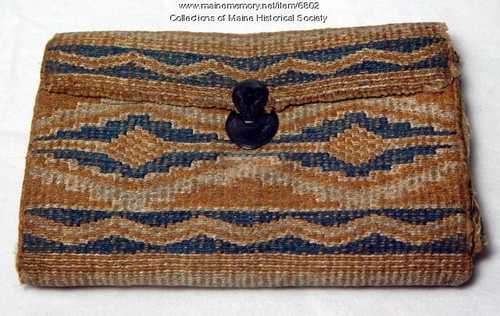Keywords: Container
Item 23497
Contributed by: Hudson Museum, Univ. of Maine Date: circa 1820 Media: Wood
Item 104965
Wabanaki birch bark container, Greenville, ca. 1900
Contributed by: Maine Historical Society Date: circa 1900 Location: Greenville Media: Birchbark
Item 151162
Cape Elizabeth High School, Cape Elizabeth, 1966-1970
Contributed by: Maine Historical Society Date: 1966–1970 Location: Cape Elizabeth; Rumford; Bethel Client: Town of Cape Elizabeth Architect: Wadsworth, Boston, Dimick, Mercer & Weatherill
Item 151580
Winthrop Library, Winthrop, 1916
Contributed by: Maine Historical Society Date: 1916 Location: Winthrop Client: unknown Architect: John Calvin Stevens and John Howard Stevens Architects
Exhibit
Desserts have always been a special treat. For centuries, Mainers have enjoyed something sweet as a nice conclusion to a meal or celebrate a special occasion. But many things have changed over the years: how cooks learn to make desserts, what foods and tools were available, what was important to people.
Exhibit
Mural mystery in Westport Island's Cornelius Tarbox, Jr. House
The Cornelius Tarbox, Jr. House, a well-preserved Greek Revival house on Westport Island, has a mystery contained within--a panoramic narrative mural. The floor-to-ceiling mural contains eight painted panels that create a colorful coastal seascape which extends through the front hallway and up the stairwell. The name of the itinerant painter has been lost over time, can you help us solve the mystery of who he or she was?
Site Page
Presque Isle: The Star City - Main Street, Presque Isle, ca. 1895
"This image is contained in the nine-volume published collection of photographs titled, "Art Work of Aroostook County, Maine," Chicago, 1895, v."
Site Page
Life on a Tidal River - Football Oracle Page 4
"It contains a brief report of their last game of the season as well as a list of all the players on the team."
Story
Mali Agat (Molly Ockett) the famous Wabanaki "Doctress"
by Maine Historical Society
Pigwacket Molly Ockett, healing, and cultural ecological knowledge
Story
Canadian immigrant founds worlds largest paper company in 1898
by Hugh J. Chisholm
Hugh J. Chisholm founded International Paper, which was the world's largest paper company in 1898.
Lesson Plan
Longfellow's Ripple Effect: Journaling With the Poet - "The Bridge"
Grade Level: 6-8, 9-12, Postsecondary
Content Area: English Language Arts, Social Studies
This lesson is part of a series of six lesson plans that will give students the opportunity to become familiar with the works of Longfellow while reflecting upon how his works speak to their own experiences.
Lesson Plan
Grade Level: 9-12
Content Area: Social Studies, Visual & Performing Arts
When European settlers began coming to the wilderness of North America, they did not have a vision that included changing their lifestyle. The plan was to set up self-contained communities where their version of European life could be lived. In the introduction to The Crucible, Arthur Miller even goes as far as saying that the Puritans believed the American forest to be the last stronghold of Satan on this Earth. When Roger Chillingworth shows up in The Scarlet Letter's second chapter, he is welcomed away from life with "the heathen folk" and into "a land where iniquity is searched out, and punished in the sight of rulers and people." In fact, as history's proven, they believed that the continent could be changed to accommodate their interests. Whether their plans were enacted in the name of God, the King, or commerce and economics, the changes always included and still do to this day - the taming of the geographic, human, and animal environments that were here beforehand.
It seems that this has always been an issue that polarizes people. Some believe that the landscape should be left intact as much as possible while others believe that the world will inevitably move on in the name of progress for the benefit of mankind. In F. Scott Fitzgerald's The Great Gatsby a book which many feel is one of the best portrayals of our American reality - the narrator, Nick Carraway, looks upon this progress with cynicism when he ends his narrative by pondering the transformation of "the fresh green breast of a new world" that the initial settlers found on the shores of the continent into a modern society that unsettlingly reminds him of something out of a "night scene by El Greco."
Philosophically, the notions of progress, civilization, and scientific advancement are not only entirely subjective, but also rest upon the belief that things are not acceptable as they are. Europeans came here hoping for a better life, and it doesn't seem like we've stopped looking. Again, to quote Fitzgerald, it's the elusive green light and the "orgiastic future" that we've always hoped to find. Our problem has always been our stoic belief system. We cannot seem to find peace in the world either as we've found it or as someone else may have envisioned it. As an example, in Miller's The Crucible, his Judge Danforth says that: "You're either for this court or against this court." He will not allow for alternative perspectives. George W. Bush, in 2002, said that: "You're either for us or against us. There is no middle ground in the war on terror." The frontier -- be it a wilderness of physical, religious, or political nature -- has always frightened Americans.
As it's portrayed in the following bits of literature and artwork, the frontier is a doomed place waiting for white, cultured, Europeans to "fix" it. Anything outside of their society is not just different, but unacceptable. The lesson plan included will introduce a few examples of 19th century portrayal of the American forest as a wilderness that people feel needs to be hesitantly looked upon. Fortunately, though, the forest seems to turn no one away. Nature likes all of its creatures, whether or not the favor is returned.
While I am not providing actual activities and daily plans, the following information can serve as a rather detailed explanation of things which can combine in any fashion you'd like as a group of lessons.
















